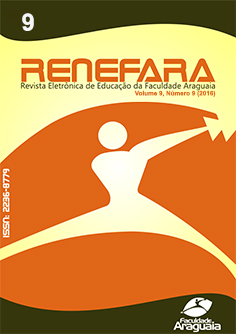O LÚDICO NO CONTEXTO DA EDUCAÇÃO FÍSICA e dA EDUCAÇÃO INFANTIL
Abstract
O presente estudo apresenta reflexões sobre as relações históricas e contemporâneas entre a Educação Física e a Educação Infantil. A Educação Física na Educação Infantil tem como um dos seus objetivos o desenvolvimento global dos alunos, procurando torná-los mais criativos independentes, responsáveis, críticos e conscientes. As atividades lúdicas têm um importante papel no contexto da Educação Infantil, desta forma deve fazer parte do cotidiano escolar. O brincar, da criança, deve ocupar um lugar especial no espaço privilegiado dentro de sala. Foi pesquisada uma instituição da rede particular, em Aparecida de Goiânia, Goiás, com intuito de observar as aulas de Educação Física, na Educação Infantil bem como uma entrevista com a professora responsável pela disciplina. Percebemos que é importante que o professor seja competente e ainda é preciso que haja métodos e criatividade para o enriquecimento dos conteúdos de acordo com a faixa etária com a qual se está trabalhando. Sendo assim, o professor, além de brincar, deve aprender a lidar com esses conteúdos e utilizar de brinquedos e brincadeiras com a função educativa, afinal por meio delas a criança entra em contato com os outros e com o ambiente, possibilitando que as brincadeiras promovam o desenvolvimento integral das crianças em todos os seus aspectos: cognitivo, motor, cultural e social.
Downloads
Published
Issue
Section
License
The copyright of the published articles will be transferred to the Uniaaraguaia Magazine, allowing its subsequent reproduction as transcription and with due citation of source. In the event of acceptance and before the publication of the article, the plaintiff (s) shall write a statement formally transferring copyright to the magazine.
The author may also print and distribute copies of his article, provided that he mentions that the rights belong to the Uniaaraguaia Magazine.
Author rights include the right to reproduce in full or partly by any means, distribute this article, including figures and photographs.
By submitting originals to the Uniaaraguaia magazine, the author or authors express agreement with the following terms:
a) Authors maintain copyright and grant Uniaraguaia magazine the right of first publication, with the work simultaneously licensed under the Creative Commons Attribution license that allows the sharing of work with recognition of the authorship and initial publication in this magazine.
b) Authors are authorized to assume additional contracts separately, for non-expiration distribution of the work version published in this magazine (eg publish in institutional repository or as book chapter), with recognition of authorship and initial publication in this journal.
c) Authors are allowed and are encouraged to publish and distribute their work online (eg in institutional repositories or on their personal page) to any point before or during the editorial process, as this can generate productive changes as well as increase the impact and citation of published work.

